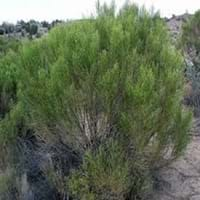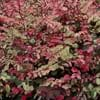Life Span
Perennial
Perennial
Origin
Hybrid origin, Southwestern United States
North America, United States, Northeastern United States, Mid-Atlantic United States, Southeastern United States, North-Central United States, South-Central United States, Texas
Types
Not Available
not available
Habitat
riparian zones, Semi desert, Upland
Boggy areas, Fens, Fields, meadows, Swamps, Woodlands
USDA Hardiness Zone
8-10
4-9
Sunset Zone
7, 8, 9, 10, 11, 12, 13, 14
1a, 1b, 2a, 2b, 3a, 3b, 4, 5, 6, 7
Habit
Spreading
Thicket/Colonizing
Flower Color
White
Not Available
Flower Color Modifier
Not Available
Not Available
Fruit Color
creamy white
Red
Leaf Color in Spring
Green
Not Available
Leaf Color in Summer
Green
Not Available
Leaf Color in Fall
Green
Not Available
Leaf Color in Winter
Green
Not Available
Leaf Shape
Oblanceolate , Ovate
Oblovate
Plant Season
Spring, Summer, Fall, Winter
Spring, Fall, Winter
Sunlight
Full Sun
Full Sun, Partial Sun
Type of Soil
Clay, Loam, Sand
Clay, Loam
The pH of Soil
Acidic, Neutral, Alkaline
Acidic, Neutral, Alkaline
Soil Drainage
Well drained
Average
Bloom Time
Spring
Late Spring
Tolerances
Drought, Dry soil, Heat Tolerance
Not Available
Where to Plant?
Ground, Pot
Ground, Pot
How to Plant?
Seedlings
Divison, Seedlings
Plant Maintenance
Medium
Medium
Watering Requirements
Needs very little water
Keep the ground moist but not water-logged
In Summer
Lots of watering
Lots of watering
In Spring
Moderate
Moderate
In Winter
Average Water
Average Water
Soil pH
Acidic, Neutral, Alkaline
Acidic, Neutral, Alkaline
Soil Type
Clay, Loam, Sand
Clay, Loam
Soil Drainage Capacity
Well drained
Average
Sun Exposure
Full Sun
Full Sun, Partial Sun
Pruning
Cut back old stems to the ground, Remove damaged leaves, Remove dead branches, Remove dead leaves
Prune after flowering, Prune in early spring, Remove damaged leaves, Remove dead branches, Remove dead leaves
Fertilizers
can go long without fertilizers
All-Purpose Liquid Fertilizer, Compost, Fertilize every year, Mulch, Nitrogen
Pests and Diseases
Pests and diseases free
Aphids, Apple Maggot, Fall Webworm, Red blotch, Scale
Plant Tolerance
Dry Conditions, Dry soil, Heat And Humidity
Not Available
Flower Petal Number
Single
Not Available
Foliage Texture
Fine
Not Available
Foliage Sheen
Glossy
Not Available
Attracts
Butterflies
Birds
Allergy
Unknown
Not Available
Aesthetic Uses
along a porch, deck or patio, Beautification, Ground Cover, Showy Purposes, Wild gardens
Showy Purposes
Beauty Benefits
Not Available
Not Available
Edible Uses
Sometimes
Yes
Environmental Uses
Air purification
Air purification
Medicinal Uses
anti-inflammatory, Anti-oxidant, cholesterol-lowering
Not Available
Part of Plant Used
Twigs
Fruits
Other Uses
Can be made into a herbal tea
Used As Food, Used as Ornamental plant
Used As Indoor Plant
No
No
Used As Outdoor Plant
Yes
Yes
Garden Design
Groundcover
Cutflower, Mixed Border, Screening, Wind Break
Botanical Name
BACCHARIS 'Centennial'
ARONIA arbutifolia
Common Name
desert broom , broom baccharis , greasewood
Red Chokeberry
In Hindi
desert broom
लाल Chokeberry
In German
Wüste Besen
Rote Apfelbeere
In French
desert broom
Red Chokeberry
In Spanish
escoba del desierto
rojo Chokeberry
In Greek
desert broom
κόκκινο Chokeberry
In Portuguese
vassoura do deserto
Red Chokeberry
In Polish
desert broom
Red aronii
In Latin
desert broom
arbutifolia
Phylum
Magnoliophyta
Magnoliophyta
Class
Magnoliopsida
Magnoliopsida
Family
Asteraceae
Rosaceae
Clade
Angiosperms, Asterids, Eudicots
Angiosperms, Eudicots, Rosids
Tribe
Astereae
Not Available
Subfamily
Not Available
Not Available
Number of Species
Not Available
Not Available
Season and Care of Desert Broom and Red Chokeberry
Season and care of Desert Broom and Red Chokeberry is important to know. While considering everything about Desert Broom and Red Chokeberry Care, growing season is an essential factor. Desert Broom season is Spring, Summer, Fall and Winter and Red Chokeberry season is Spring, Summer, Fall and Winter. The type of soil for Desert Broom is Clay, Loam, Sand and for Red Chokeberry is Clay, Loam while the PH of soil for Desert Broom is Acidic, Neutral, Alkaline and for Red Chokeberry is Acidic, Neutral, Alkaline.
Desert Broom and Red Chokeberry Physical Information
Desert Broom and Red Chokeberry physical information is very important for comparison. Desert Broom height is 60.00 cm and width 150.00 cm whereas Red Chokeberry height is 180.00 cm and width 12.70 cm. The color specification of Desert Broom and Red Chokeberry are as follows:
Desert Broom flower color: White
Desert Broom leaf color: Green
Red Chokeberry flower color: Not Available
- Red Chokeberry leaf color: Not Available
Care of Desert Broom and Red Chokeberry
Care of Desert Broom and Red Chokeberry include pruning, fertilizers, watering etc. Desert Broom pruning is done Cut back old stems to the ground, Remove damaged leaves, Remove dead branches and Remove dead leaves and Red Chokeberry pruning is done Prune after flowering, Prune in early spring, Remove damaged leaves, Remove dead branches and Remove dead leaves. In summer Desert Broom needs Lots of watering and in winter, it needs Average Water. Whereas, in summer Red Chokeberry needs Lots of watering and in winter, it needs Average Water.





